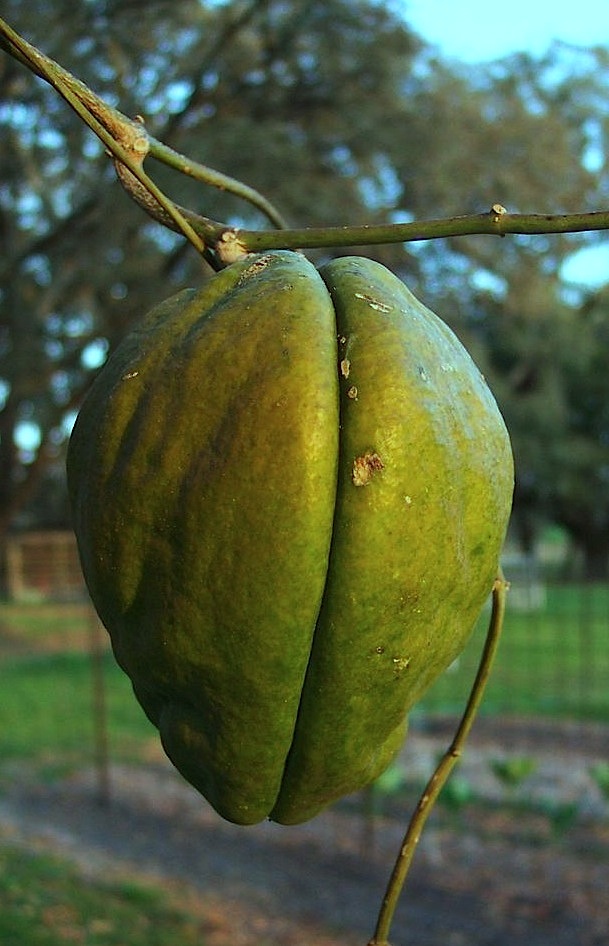
The Milkweed Vine’s pods resemble chaya squash. Photo by Onalee Israel
Millions of dollars and many decades have been spent trying to eradicate the edible pictured above. I do my part by eating as much as I can. The Latex Strangler Vine, also known as the Milkweed Vine, is on the state’s noxious weed list because it shades citrus trees to death especially in southern end of the state. The seed pod is a staple food in its native South America and is more nutritious than the citrus it kills.
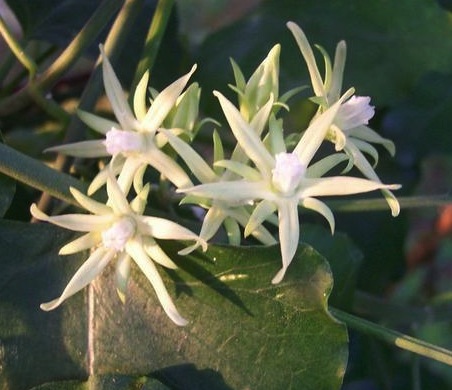
The aromatic blossoms are edible raw. Photo by Onalee Israel
In warm climates the vine will fruit all year making it a reliable source of food but also hard to control. As a tropical it does not like winter or even cool weather. My classes this weekend, however, were not where this species prefers but in Gainesville and Ocala, easily 300 miles to the north. I’ve harvested this vegetable there many years in a row because even though it’s in a northern location the vine — actually a liana, see below — has picked the perfect spot to grow. There’s a large cement-block building nearby that can radiate heat at night if needed. And the vine is under a huge Live Oak, the kind that has graceful branches touching the ground great distances from the trunk. Where the branches touch doesn’t get mowed well. So the vine escapes getting mowed, most freezes, and has a large tree to climb on (it can wend its way up 100 feet.) From the top of the tree it gets all the sun it needs, develops pods then drops them under the tree to reseed and repeat the cycle every year. Besides the cooked pods the fragrant flowers and leaves are also edible. To read more about the Latex Strangler Vine, go here.
The Little Mustards are happy now that average daily temperature is dropping. They’re lesser-known members of a huge family that are summer annuals in northern climes and winter annual where we have mild winters.
The first one I saw — Hairy Bittercress — was spotted at the base of a well-irrigated Magnolia. Hairy Bittercress tolerates damp ground and is often found along the edges of small streams or ponds. And for a change its common name reflects the wispy plant. It is slightly bitter and there is a little bit of hair at the base of the stem where it turns purplish. The Bittercress also has toothpick-like seedpods which help in the identification. Of all the Little Mustards locally it probably has the longest season persisting into warm weather if it has some shade in a wet spot. And once you see one seasonal Little Mustards the rest will be soon along. You can learn more about them here and here.
A closely related species that was also just starting to grow was Shepherd’s Purse, Capsella bursa-pastoris, above right. Unlike Poor Man’s Pepper Grass which can be very peppery — and common — Shepherd’s Purse is milder in flavor and more finicky about time of year. The Pepper Grass is here all year, the Shepherd’s Purse favors the winter. It is also more consistent in appearance from sprout to adult. The Pepper Grass can vary greatly which is one of the challenges of identifying that species. You can read about the Pepper Grass and the Shepherd’s Purse here.
Recent newsletters have mentioned the sighting of pellitory and chickweed and this weekend was no exception. Chickweed was in abundance and as reported before is early this year. This past Sunday also provided another winter annual, stinging nettles. For many people the topic of stinging nettles is confusing. We have two plants called the stinging nettle. They look very different and are in two different genera but is still confusing. One nettle is here nearly all year, the Cnidoscolus stimulosus, also known as the Spurge Nettle. It has palmate leaves with three to five lobes and produces an edible root. The entire plant above ground is covered with stinging hairs, even the petal blossoms. It’s related to Chaya, Cnidoscolus aconitifolius, the “spinach tree” which will also grow here in Florida.
The other nettle is a seasonal Urtica. It’s the genus most of the rest of the world refers to when they say stinging nettle, in this case Urtica chamaedryoides the “burning dwarf.” It is called that because it rarely exceeds a foot in height and has one of the worse nettle stings on earth. It may be tiny but if it stings you you can be in big pain for many days. Its sting actually gives me welts that hurt for several days. Then that area is sensitive to water for many days after that. However, it is also very edible once you take the sting out. That can be done by crushing, wilting, cooking and, oddly, refrigerating the plant. Wilting it over a campfire then consuming it then and there I think is the best and tastiest way to eat this stinging nettle. There’s also no pots or pants to clean up. To read more about the burning monster go here.
Something old something new. In northern Europe some “daycare” centers are abandoning buildings. The kids stay outside all day. Saying there’s no such thing as bad weather only bad clothing “forests kindergartens” as they are called are becoming popular. The kids get to run around and learn about nature. They also play with toys fashioned out of what’s around them rather than manufactured toys. Activities can include climbing trees, exploring the woods, hide and seek, listening to stories, building shelters, making snow forts and the like. The movement also takes the position that the staff is there to assist the children in the exploring and doing but not to lead them. Of course a first-year law student in the United States could think of several reasons why that should never be done in America.
One of the students who showed up for my foraging class in Gainesville Saturday was clearly an expert at it, a white-tailed deer, Odocoileus virginianus. She browsed on a wide variety of leaves while I waited for my two-legged students to arrive. The doe nibbled on Smilax — a deer favorite — and beautyberries, sniffed at acorns and avoided mushrooms. I thought she had left by the time I started my class but I think she was actually listening in because later she demonstrated for the whole class how Bidens alba is edible (by her and us.) While deer usually browse at night they will also feed during the early morning or on overcast days.
A reminder the Florida Herbal Conference 2014 will be held in Deland again this coming February. Nationally known herbalist Susan Weed will be among the featured speakers. For the third year in a row I will be leading weed walks at the herbal conference along with Mycol Stevens and Andy Firk. My walks are usually first thing in the morning when the air is cool and camp fires warm. Although it is the Florida Herbal Conference it draws teachers and students from all over North America.
Though your foraging may drop off during the winter it’s a great time to study wild edibles with my nine DVD set. Each DVDs has 15 videos for 135 in all. They make a great Christmas gift. Order today. Some of these videos are of better quality than my free ones on the Internet. They are the same videos but many people like to have their own copy. I burn and compile the sets myself so if you have any issues I handle them personally. There are no middle foragers. And I’m working on adding a tenth DVD. To learn more about the DVDs or to order them click here.
Botany Builder #28: Liana (lee-Ah-nah) is what Tarzan swung through the jungle on. It is a woody climbing plant that grows from the ground into the tree canopy. Another word that means the same thing is Liane (LEE-ahn.) Both come down from Dead Latin through French. In Dead Latin “ligatura” means a twisting or binding. In French that became lier, to bind. That led to liana and liane in English. While lianas do lend some support to trees in high wind they are generally not good for trees. But they do provide tree-dwellers including Tarzan ready access to the trees, ground, or other trees. Their vascular tissues have been modified primarily for water conduction as the vines have to get water up 100 feet or more.
From the Mail: It’s good to know one can make a difference: Good A.M. I wish to express my heartfelt gratitude for visiting your website. The information will really help us in surviving these hard times especially when my country [The Philippines] was recently ravaged by Typhoon Haiyan [Yolanda].
To donate to the Green Deane Newsletter or Website click here.

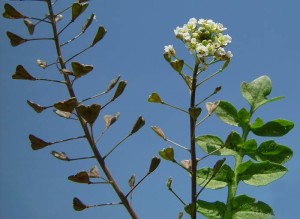
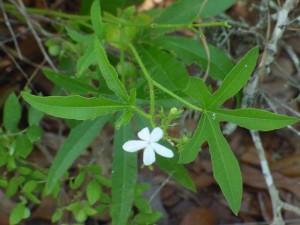
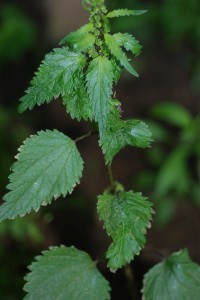
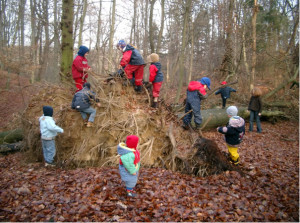
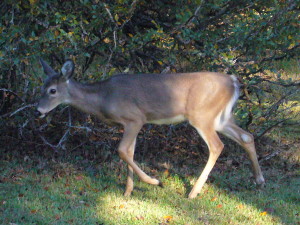




Love your infromative letters. Happy hunting.
Happy to be here. First few flakes of snow fell today here in Ukraine.I would like to know please…we have a very small patch of non=stinging looks like nettle down by an inlet of the Dnepr River. I smoothied it all summer and now it has died right down. Any ideas on what it might be? How to find your reply?
That’s great to hear about the outdoor preschools in Northern Europe. I read a handful of articles studies about their growing popularity. Turns out playing outside and creating playthings out of natural elements leads to greater dexterity and more complex motor skills. See “The Natural Environment as a Playground for Children: The Impact of Outdoor Play Activities in Pre-Primary School Children” by Ingunn Fjørtoft as an example.
Hi Green, Big fan. I am into this wild edible stuff hook, line and sinker. I wish to find others, or groups in my area to to further my skills and interest, but I am having a very hard time finding much of anything on the net. So I figure, ask someone who knows the subject well. Perhaps you have contacts that could help direct me. I’m in south central Virgina, Danville to be exact. Very close to NC. Thanks for any help. Have a great Thanksgiving.
p.s. I’m gonna be eating traditional Thanksgiving dinner, lol. But, I’m sprouting some dandelions at the moment, the super food.
In the search window on my home page type in “resources”. That will take you to a page of foraging teachers. Scroll down to Virginia or North Carolina. Email those teachers nearest to you. They should know of folks in your area to contact.
(Or there is a drop down menu under foraging that says Foraging Instructors. That will take you to the same page. )
Isn’t it sad to find that other countries have the freedom to teach their children outdoor wonderment and creativity while we are held captive by those who prefer law suits and quick bucks.
no help for my question please?
I suggest you type RESOURCES in my search window to find the Foraging Instructors page. Scroll down to the bottom. Email Peter Becker, Francois Couplan, or Henriette Kress. As they are closer to you they might be able to help.
It is sad to leave such a prolific place where every niche is liable to gratify a forager’s “lust”. That place is around Spring and Station Roads in the calm beautiful Southampton City. Here I’ve been enjoying foraging mostly in the company of my lovely grandson, Yusuf, whose generous ideal parents have secured me a happy stay for a couple of months. Here I am pretty sure that within ten old Oak trees, three are being perfectly embraced by the Strangler Latex Vine, Morenia odorata. However, I can witness neither fruits nor flowers on these. In this issue of Eattheweeds, I am delighted to see the picture on “day care” on the forest which depicts very clearly the indulgence of every member of the group in some kind of useful work. I think we have to encourage such activities in our developing countries by making them part of the school curriculum. Usually our schools allot only one day during the whole year, the so called “The Tree Day” for the school pupils to go out of their class rooms on the purpose of transplanting trees on the side of roads or near their homes. Unfortunately, that being performed, those trees are left without care thereafter. Posted by Farouk